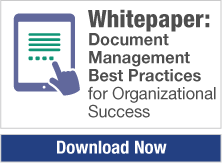What is Document Capture?
How is it Different Than Document Scanning?
Without a document management system, document capture is the process of opening the mail, routing the document to the appropriate person in your organization, and then having that person file the document. With document management, document capture of paper documents is the process of scanning that documents through an online document scanner. It then becomes a digital document. When done correctly, these digital copies can be used as the legal original copy. Later, we will discuss the legal aspects of preserving documents digitally, but for now let’s, focus on the capture process.
Scanning Documents
Scanning documents creates an image of the document in a format that can be viewed online. Most people are familiar with PDF files. That is just one format. Other formats are used for document capture solutions, too.
Every format has its benefits. For example:
- TIF format: most documents that are scanned are turned into TIF format, which compresses documents so they do not take up a lot of storage and at the same time enables them to be indexed on a page level. So if you had a 100 page contract to scan in, then TIF would be a better format than PDF as it would be better indexed.
- PDF format: if the contract was created in MS-Word, and you created the PDF directly out of Word, then the PDF document would be smaller than a scanned TIF file. Further, a PDF created from a Word document would probably be a better quality image than a scanned document. As with all things, there are pluses and minuses to every choice.
While we discussed scanning paper documents, we should keep in mind that all documents are not black and white. You might have scanned a picture. Think of a contract for a piece of property. It might have pictures of the property as exhibits. Pictures might be scanned in as TIF documents, but they could also be JPEG files or even other formats. Again, different formats have different benefits.
Importing Documents
Document capture is not just the process of scanning paper documents. Document capture also takes into account electronic documents. In the example above, we referenced creating a PDF from an MS-Word document. Keep in mind the MS-Word document is already an electronic document. You might want to have the original Word document or a PDF in your document management system for future reference. This leads to the concept of importing electronic documents into your system.
Remember that the power of a document management system is the ability to tie all your documents together. In addition to the file cabinets of paper documents, you have large numbers of important electronic documents. These electronic documents are just as important as the paper files, maybe even more important in many instances.
Importing documents is a different process than scanning. However, you may choose not to import various electronic records. For example, records in your accounting system will probably not be imported into your document management system. Yet, these electronic records are critical to having a successful and efficient document management system.
There are two ways to accommodate these records with document management. One way is to link to the accounting system to pull in the data from these records. The more common way is to have the accounting system link to the document management system and display the information needed. That way, in this example, the AP team uses the accounting system for their work and when they need the supporting documentation, the accounting system requests them from the document management system.
Later we will discuss implementing a document management system and tying it to your existing applications. For now we need to explore how documents are indexed for storage and retrieval.
What is Document Management? << Previous Page • Next Page >> What is Document Indexing?




